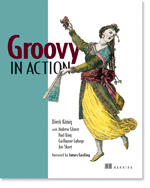 I have already noticed a couple of GINA's reviews out there, but I still thought to post mine. Yes, I know this one can be considered a bit more subjective than others having in mind that lately I played more and more with Groovy, I have implemented support for annotations in Groovy and already released the 1.0 of Test'N'Groove (integration of TestNG and Groovy -- but I will write more about it some other time).
I have already noticed a couple of GINA's reviews out there, but I still thought to post mine. Yes, I know this one can be considered a bit more subjective than others having in mind that lately I played more and more with Groovy, I have implemented support for annotations in Groovy and already released the 1.0 of Test'N'Groove (integration of TestNG and Groovy -- but I will write more about it some other time).During the last months I have been reading a lot about different programming languages: Common LISP, Python, Scala, etc. So, I would say that my brain was in a new programming language mood. And, even if some may hate me for this, I would say that writing a book about a PL is an easy job. Depending on the target you set and on your experience and knowledge, you pick the subjects you are best in and develop around those. The hard part is to make your book the Bible of that programming language, the first book people will be looking for when starting to learn that language. And even harder is to make it attractive and fun and entertaining for your readers. At this point I must confess that I read GINA in less than 3 days, even if it has more than 600 pages (oke, I confess I haven't read it all, but for sure more than 80% of it). And not only that I got that feeling that it is so fun that I cannot stop myself, but I think it fulfills all the characteristics of great and absolutely enjoyable PL book.
For the beginning here is a short description of Groovy's power:
Some languages may have a few more features than Groovy. Some languages may claim to integrate better with Java. None can currently touch Groovy when you consider both aspects together: Nothing provides a better combination of Java friendliness ''and'' a complete range of modern language features.The Groovy in Action authors, many of them part of the Groovy specification and development team, will walk you through almost all interesting features of Groovy (closures, builders, dynamic object orientation, Groovy Standard Library) -- and I still believe they haven't left many out :-). The reader is introduced step by step in the world of Groovy, getting more and more knowledge by every page. The book doesn't stop at theoretical aspects of Groovy language, but it is also presenting the reader with pragmatic aspects as working with databases, working with XML, integration with Spring and integration in Mustang, performing Windows specific tasks. The book has also a special place for Grails one of the most important (if not the most) framework based on Groovy.
Finally, without any fear, I would say that Groovy in Action is not just a language guide, but represents the clear, readable and enjoyable specification of Groovy (and you should definitely read it and start playing with Groovy [blink/] ).

2 comments:
oh you tease, show us more information on Test'N'Groove, pretty please ?
Great site buddy . Really I like ur site I think u r also a Java Developer like me any ways I have some reference books of java which are readable .... Following are the books
Programmer's Guide to Java
Certification A Comp. Primer SE
By Khalid A. Mughal, Rolf W. Rasmussen Publisher : Addison Wesley
Pub Date : August 04, 2003
Java™ Development on PDAs
Building Applications PocketPC
By Daryl Wilding-McBride Publisher : Addison Wesley
Pub Date : June 05, 2003
Learning Java™, 2nd Edition
Publisher : O'Reilly Pub Date : July 2002
Pub Date : June 05, 2003
Jython for Java Programmers
By Robert W. Bill Publisher : New Riders Publishing
Pub Date : December 21, 2001
Enterprise JavaBeans, 3rd Edition
By Richard Monson-Haefel Publisher : O'Reilly
Pub Date : September 2001
Java 1.5 Tiger: A Developer's Notebook
By David Flanagan, Brett McLaughlin Publisher : O'Reilly
Pub Date : June 2004
Java Tutorials Index 1
Java Data Objects
By David Jordan, Craig Russell Publisher : O'Reilly
Pub Date : April 2003
Java™ Extreme Programming Cookbook
By Eric M. Burke, Brian M. Coyner Publisher : O'Reilly
Pub Date : March 2003
Java™ Performance Tuning, 2nd Edition
By Jack Shirazi Publisher : O'Reilly
Pub Date : January 2003
Java™ Performance Tuning, 2nd Edition
By Jack Shirazi Publisher : O'Reilly
Pub Date : January 2003
JavaScript & DHTML Cookbook
By Danny Goodman Publisher : O'Reilly
Pub Date : April 2003
Java Servlet & JSP Cookbook
By Bruce W. Perry Publisher : O'Reilly
Pub Date : January 2004
Java Tutorials Index 2
Post a Comment